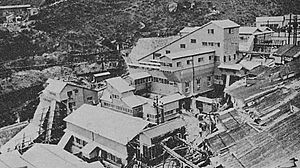History of Taiwan facts for kids
Taiwan is an island in eastern Asia. Its first people were related to groups from the Pacific Ocean, with a small number of Chinese people. In the 1600s, the Dutch arrived. Many Chinese people then moved to Taiwan to work. Few Europeans settled there. The native people either married Chinese settlers or moved away from the western part of the island.
Later, when the Qing dynasty started in China, a supporter of the old Ming dynasty found a safe place in Taiwan. Eventually, the Qing forces came to Taiwan, defeated him, and made Taiwan part of China.
Taiwan stayed Chinese territory for most of the Qing dynasty. Then, in 1895, Japan took control. Taiwan was a colony of Japan for 50 years until World War II ended. For a short time, China's Guomindang government controlled Taiwan. However, that government lost a civil war in China and moved to Taiwan. The Guomindang's rule is still talked about today. Some people criticize how they treated the Taiwanese people. Others focus on the good political and economic changes they made.
In the 1980s, Taiwan's government became more democratic. This change allowed different political parties to compete. The Democratic Progressive Party became more powerful. During this time, Taiwan has officially been called the Republic of China. But it has acted like an independent country. The People's Republic of China says Taiwan must become part of China. Most Taiwanese people are still discussing what Taiwan's political status should be today. These different ideas make Taiwan's politics complicated.
Contents
Early History of Taiwan
The first people to live in Taiwan are called the Aboriginal people. They share many similarities with other groups known as Austronesian people. Chinese historians have mentioned Taiwan several times since China's Three Kingdoms period. Back then, it was seen as a land of "barbarians."
Stone Age in Taiwan
About 50,000 years ago was the "Old Stone Age" in Taiwan. During this time, people made tools by hitting rocks together. The most famous culture from Taiwan's Old Stone Age is the Changping Culture. A well-known site of the Changping culture is the Eight Gods' Hole Monument in Taitung Conty.
About 5,000 years ago was the "New Stone Age." People in the New Stone Age sharpened stones to make their tools. We can divide the New Stone Age into three parts. The most famous cultures are the Tapenken culture, the Beinan culture, and the Yuanshan culture. The Tapenken culture's site is the Tapenken Monument in Taipei. The Beinan culture's site is the Puyuma Relics in Taitung Conty. The Yuanshan culture's site is the Yuanshan Monument in Taipei City.
Metal Age in Taiwan
About 2,000 years ago was the "Metal Age." In the Metal Age, people started using metal to make tools. They also began trading with others. The most famous culture from the Metal Age is the Thirteen Hangs Cultures. Its important site is the Thirteen Hangs Monument in Taipei County.
Dutch Rule in Taiwan
In the 17th century, the Dutch took control of Taiwan. During this time, Taiwan was a Dutch colony. The Dutch encouraged Chinese people to move there. Before this, few Chinese people had lived on Taiwan. As more Chinese moved to Taiwan, there were conflicts with the Aboriginal people. The Aboriginal people either married Chinese settlers or moved away from the western part of Taiwan. While the Dutch were in control, Spain also briefly held northern Taiwan. But the Dutch removed them in 1642.
Qing Dynasty Rule
In 1644, the Qing dynasty began ruling China. A supporter of the Ming dynasty, named Koxinga, landed in Taiwan. He removed the Dutch and ruled Taiwan. He made Taiwan a place to resist the Qing Dynasty. This time is called "the period of Ming Zheng" or the Kingdom of Tungning. One year later, the Qing Dynasty ended the Kingdom of Tungning. The Qing Dynasty ruled Taiwan for 212 years, until 1895.
Japanese Rule
Japan first became interested in Taiwan in the 1870s. They tested how strong the Qing Dynasty's control was in 1871. Some Okinawan fishermen were shipwrecked and killed by Aboriginal people in southern Taiwan. Japan demanded payment for this. Okinawa had secretly paid tribute to both China and Japan. In this situation, Japan said Okinawa was part of Japan and that it had to protect its own people. There was no war, but China said it could not control "barbarian" people. Japan used this as an excuse to demand Taiwan after it defeated China in the First Sino-Japanese War.
Taiwanese people rebelled without China's support. They created the Republic of Formosa, which lasted for about one year. Japan stopped the Taiwanese resistance. But this event was the start of Taiwanese nationalism, a feeling of pride and unity among Taiwanese people.
Guomindang Rule
In 1945, the Republic of China won the Second Sino-Japanese War. The Allied Powers agreed to divide the land that Japan had controlled. Taiwan was to be returned to Chinese control. The Chinese civil war was happening at this time. In 1949, the Guomindang party lost the civil war and moved to Taiwan. Taiwan was ruled by this one party until democratic changes began in the 1980s.
Images for kids
-
A replica of an East Indiaman ship from the Dutch East India Company.
-
A bird's eye view of Fort Zeelandia in Dutch Formosa in the 17th century.
-
The land controlled by Koxinga, who founded the Kingdom of Tungning.
-
A 1912 map of Japan with Taiwan, which was ruled by the Empire of Japan from 1895 to 1945.
-
U.S. President Dwight D. Eisenhower waving to crowds with President Chiang Kai-shek during his visit to Taipei in June 1960.
-
The Chinese Civil War caused very high inflation. Money was printed in amounts like 1 million Old Taiwan dollars.
See also
 In Spanish: Historia de Taiwán para niños
In Spanish: Historia de Taiwán para niños




















